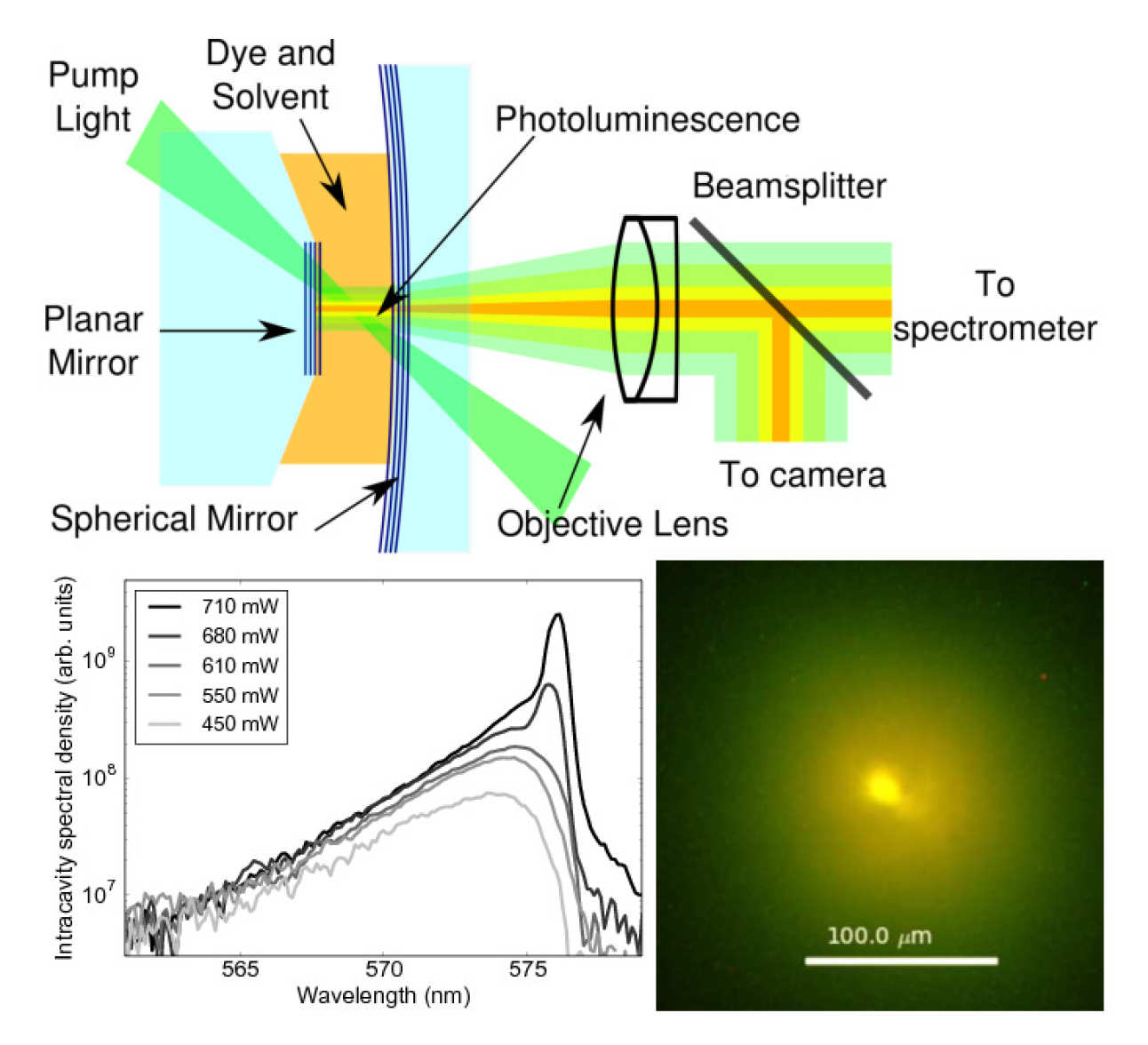Photon BEC
Bose-Einstein Condensation of Photons
At low temperature and high density, a fluid has properties which depend enormously on the quantum nature of the particles it's made of, whether they are bosons or fermions. Bosons tend to bunch together, and in extreme cases form a giant wave called a Bose-Einstein Condensate (BEC). This quantum state can be seen in wildly differing physical systems, from liquid helium to electron pairs in superconductors to laser-cooled atoms in vacuum chambers: for example, other experiments in CCM. In 2010, BEC was seen for the first time at room temperature for photons trapped in a dye between mirrors: Klaers et al, Nature, vol 468, p545. In May 2014 we observed our first photon BECs, becoming only the second lab in the world (to our knowledge) to do so.

Light is made of photons, which are bosons. Photons can be absorbed by a fluorescent dye, and bounced between two mirrors just 2 millionths of a metre apart, for one billionth of a second. That's more than long enough for the photons to come into thermal equilibrium with the dye, at room temperature. If we shine a bright enough light onto the dye, the photon number density can be high enough to make a BEC.
The mirrors are curved to confine the light: the shape of the mirrors gives an effective potential energy. Part of this project will be developing custom-shaped mirrors to confine photons so that they can only move in one dimension. Another part will be looking at the coherence of the photon BEC (how it shows interference). The photons in the dye medium interact with each other, unlike light beams in free space. We will study those photon interactions. We will also look at how the photon BEC behaves away from thermal equilibrium. The end result of this project will be an understanding of how photon BECs form, what are their properties, and their interactions, as well as the ability to make them in arbitrary sizes and shapes.
More information
News
- We're organising a scientific workshop on "Condensates of Light", both quantum and classical. It will be held 14-17 January 2018 in Bad Honef, Germany. More details can be found here.
Publications from the project
- B. T. Walker, L. C. Flatten, H. J. Hesten, F. Mintert, D. Hunger, J. M. Smith, R. A. Nyman. Driven-dissipative Bose-Einstein condensation of just a few photons. ArXiv preprint available here.
- H. J. Hesten, R. A. Nyman and F. Mintert. Decondensation in non-equilibrium photonic condensates: when less is more. ArXiv preprint available here.
- R. A. Nyman and B. T. Walker, Bose-Einstein condensation of photons from the thermodynamic limit to small photon numbers. ArXiv preprint available online here.
- J. Marelic, B. T. Walker and R. A. Nyman, Phase-space views into dye-microcavity thermalised and condensed photons. Physical Review A, 94, 063812 (2016). Also available at arXiv:1609.01554
- R. A. Nyman, Viewpoint: Liquid Light with a Whirl, Physics, 9, 88 (2016)
- J. Marelic, L. F. Zajiczek, H. J. Hesten, K. H. Leung, E. Y. X. Ong, F. Mintert and R. A. Nyman, Spatiotemporal coherence of non-equilibrium multimode photon condensates, New Journal of Physics, 18, 103012, (2016)
- M. Kohnen and R. A. Nyman, Temporal and spatiotemporal correlation functions for trapped Bose gases, Physical Review A, 91, 033612 (2015).
- Jakov Marelic and R.A. Nyman, Experimental Evidence for Inhomogeneous-Pumping and Energy-Dependent Effects in Photon Bose-Einstein Condensation, Physical Review A, 91, 033813, (2015). Also available at arXiv:1410.6822
- R.A. Nyman and M.H. Szymanska, Interactions in dye-microcavity photon condensates and the prospects for their observation, Physical Review A, 89, 033844 (2014). Also available at arxiv:1308.3588
Team Members
- Rob Nyman. Principal Investigator, EPSRC Research Fellow
- Florian Mintert, Lecturer
- Jakov Marelic, PhD student (2013 - 2018)
- Lydia Zajiczek, MSc student (2014, Summer)
- Henry Hesten, PhD student (MRes 2015, then 2015 - )
- Ben Walker, PhD Student (MRes 2016, then 2016 - )
- Pedro Vianez, MSc Student (2017, Summer)
For more information, please contact Rob Nyman [r.nyman@imperial.ac.uk]


